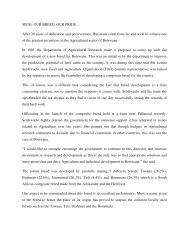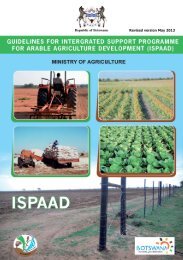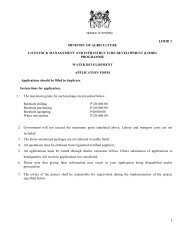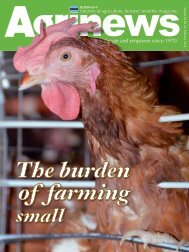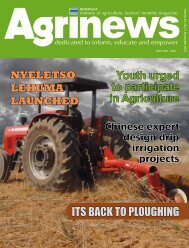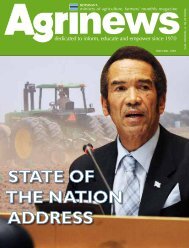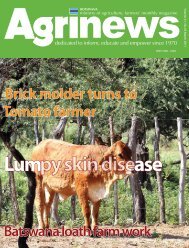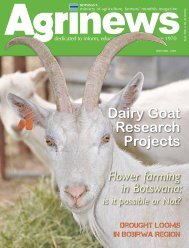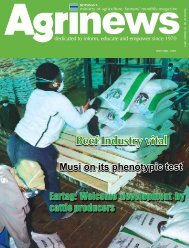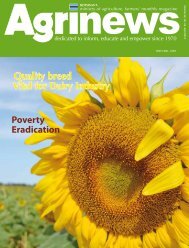GHANZI SHOW - Ministry of Agriculture
GHANZI SHOW - Ministry of Agriculture
GHANZI SHOW - Ministry of Agriculture
You also want an ePaper? Increase the reach of your titles
YUMPU automatically turns print PDFs into web optimized ePapers that Google loves.
THE SECRET<br />
BEHIND THE<br />
PANDAMATENGA<br />
SUCCESS<br />
Article: Keamogetse Boitshepo<br />
Improved technology in use in Pandamatenga<br />
” Botswana Food Basket” like<br />
is commonly referred to lay<br />
stretched 50 000 hectares<br />
about 900 kilometers north <strong>of</strong><br />
Gaborone in a fertile black cotton<br />
soil <strong>of</strong> Chobe. Pandamatenga<br />
commercial farms prove annually<br />
to have the potential to pioneer<br />
commercial farming in Botswana.<br />
In only 12% <strong>of</strong> the hectares planted<br />
in Botswana, Pandamatenga<br />
commercial farms produce about<br />
90% <strong>of</strong> the locally produced cereal<br />
grain.<br />
In 2010/11 planting season, the<br />
farmers planted 22 000 hectares<br />
and produced 43 000 tonnes <strong>of</strong><br />
cereal grain. That means on average<br />
Pandamatenga commercial farms<br />
produce 2.5 tonnes per hectare.<br />
Most arable farmers cry foul over<br />
lack <strong>of</strong> rains and prevalent weeds<br />
and pests producing on average<br />
200kg <strong>of</strong> cereal grains per hectare.<br />
The big questions is; what is<br />
Pandamatenga commercial farmers<br />
doing different?<br />
Agrinews had an exclusive<br />
interview with Mr Tienie Kruger, the<br />
chairperson <strong>of</strong> the Pandamatenga<br />
Commercial Farmers Association<br />
(P.C.F.A).<br />
Kruger explains that just like<br />
Rome was not built in one day,<br />
Pandamatenga as well took years <strong>of</strong><br />
hard work to build. He reminisces<br />
<strong>of</strong> the time the farms were nearly<br />
closed due to frequent floods that<br />
affected farming processes resulting<br />
in the farms operating at a loss.<br />
At the time, he said government<br />
established a commission which<br />
resulted in government investing<br />
millions <strong>of</strong> pula on drainage work<br />
and access roads.<br />
He credits the then President<br />
Festus Mogae and Minister <strong>of</strong><br />
<strong>Agriculture</strong> Jonny Swartz as pioneers<br />
<strong>of</strong> the change in Pandamatenga.<br />
“What you see today is the<br />
expansion <strong>of</strong> Panda farms and<br />
drainage system being put in place.<br />
Additional land <strong>of</strong> 22 000 hectares<br />
was initiated by this two people and<br />
an investment <strong>of</strong> P400 million was<br />
made available to support farmers.”<br />
Kruger was quick to give the farmers<br />
credit for their perseverance, which<br />
somewhat inspired the government<br />
to take action. He, however, could<br />
not over emphasize the importance<br />
<strong>of</strong> government involvement in<br />
farming and cooperating with<br />
farmers.<br />
According to Kruger, government<br />
assistance did not swipe away all<br />
their challenges as by then they<br />
were struggling to understand the<br />
black cotton soil. With time and<br />
improvement <strong>of</strong> equipment and<br />
chemicals he said they discovered<br />
better ways <strong>of</strong> planting the area.<br />
Out <strong>of</strong> that, two schools <strong>of</strong> thoughts<br />
were born, the old and the new but<br />
all practice precision planting.<br />
The old school which Kruger also<br />
subscribes to include harrowing or<br />
disking <strong>of</strong> field; that is doing various<br />
processes <strong>of</strong> preparing the seed bed<br />
before planting. The new school <strong>of</strong><br />
thought does minimum tillage and<br />
is more chemical based as opposed<br />
to ploughing and preserving the soil.<br />
He, however, said both schools<br />
ascribe to improved crop population,<br />
seed depth and other processes that<br />
July 2012 4



